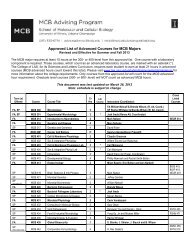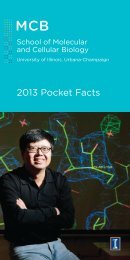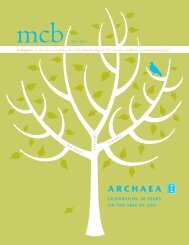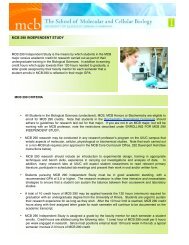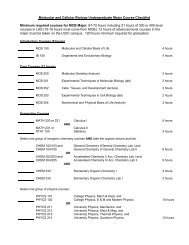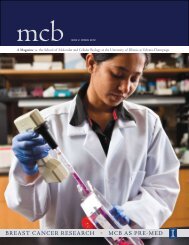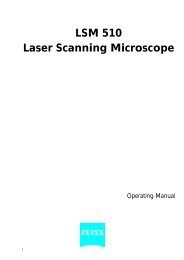collaboration in the life sciences - The School of Molecular and ...
collaboration in the life sciences - The School of Molecular and ...
collaboration in the life sciences - The School of Molecular and ...
Create successful ePaper yourself
Turn your PDF publications into a flip-book with our unique Google optimized e-Paper software.
stephen SLIGAR<br />
I. C. Gunsalus Pr<strong>of</strong>essor <strong>of</strong> Biochemistry<br />
<strong>and</strong> Chemistry <strong>and</strong> Director <strong>of</strong> <strong>the</strong><br />
<strong>School</strong> <strong>of</strong> <strong>Molecular</strong> <strong>and</strong> Cellular Biology<br />
Stephen Sligar recognized that remov<strong>in</strong>g <strong>the</strong> globular part<br />
<strong>of</strong> apoA would create prote<strong>in</strong>s that can act as generic scaffolds<br />
for discs <strong>of</strong> lipid bilayer, <strong>in</strong>to which might be <strong>in</strong>corporated<br />
membrane prote<strong>in</strong>s. <strong>The</strong>se “nanodiscs,” bounded by two<br />
membrane scaffold prote<strong>in</strong>s (MSPs), would provide an unprecedented<br />
molecular tool for study<strong>in</strong>g membrane prote<strong>in</strong>s<br />
<strong>and</strong> <strong>the</strong>ir <strong>in</strong>teractions with soluble partners, as well as <strong>the</strong><br />
<strong>in</strong>fluence <strong>of</strong> <strong>the</strong> lipid composition.<br />
Studies us<strong>in</strong>g nanodiscs by <strong>the</strong> Sligar lab, <strong>of</strong>ten <strong>in</strong> wide-rang<strong>in</strong>g<br />
<strong>collaboration</strong>s, have successfully <strong>in</strong>corporated many membrane<br />
prote<strong>in</strong>s <strong>and</strong> complexes, <strong>in</strong>clud<strong>in</strong>g various enzymes, <strong>the</strong><br />
full-size trimer <strong>of</strong> bacteriorhodops<strong>in</strong>, visual rhodops<strong>in</strong>, <strong>the</strong><br />
β 2<br />
-adrenergic receptor, a complete chemotactic signal<strong>in</strong>g complex,<br />
<strong>and</strong> <strong>the</strong> prote<strong>in</strong> secretion channel from yeast, amongst<br />
o<strong>the</strong>rs.<br />
Putt<strong>in</strong>g it all toge<strong>the</strong>r<br />
For Jim Morrissey <strong>the</strong> nanodisc technology on his doorstep<br />
was <strong>the</strong> perfect answer for study<strong>in</strong>g <strong>the</strong> <strong>in</strong>teractions between<br />
tissue factor—which has a transmembrane anchor, <strong>and</strong> its<br />
immediate substrate, fVII—<strong>and</strong> between <strong>the</strong> activated TFfVIIa<br />
complex <strong>and</strong> its targets <strong>in</strong> <strong>the</strong> protease cascade. Not<br />
only could TF be readily <strong>in</strong>corporated <strong>in</strong>to nanodiscs, but <strong>the</strong><br />
lipid composition <strong>of</strong> <strong>the</strong> membrane bilayer could be easily<br />
controlled, allow<strong>in</strong>g a highly quantitative analysis <strong>of</strong> <strong>the</strong><br />
<strong>in</strong>fluence <strong>of</strong> specific lipids on <strong>the</strong> protease activity. Initially,<br />
very high levels <strong>of</strong> <strong>the</strong> negatively charged lipid, phosphatidylser<strong>in</strong>e<br />
(PS), seemed to be required for maximum activity,<br />
much higher than are present <strong>in</strong> cell membranes. However, it<br />
became apparent that <strong>the</strong> rest <strong>of</strong> <strong>the</strong> lipid composition is also<br />
critical <strong>and</strong>, with <strong>the</strong> right comb<strong>in</strong>ation, PS was found to have<br />
its maximum effect at lower, natural concentrations.<br />
<strong>The</strong> reason <strong>the</strong> membrane composition is so important is<br />
thought to be that <strong>the</strong> active sites <strong>of</strong> <strong>the</strong> clott<strong>in</strong>g factors, such<br />
as fVIIa, <strong>and</strong> target sites <strong>of</strong> <strong>the</strong> substrates, e.g. fX, must be<br />
held <strong>in</strong> l<strong>in</strong>e, at just <strong>the</strong> right height above <strong>the</strong> membrane surface.<br />
This geometric constra<strong>in</strong>t is achieved partly by b<strong>in</strong>d<strong>in</strong>g<br />
fVIIa to TF <strong>and</strong> partly by <strong>in</strong>teractions between <strong>the</strong> prote<strong>in</strong>s<br />
<strong>and</strong> <strong>the</strong> lipid headgroups, mediated by calcium ions.<br />
Factors VII <strong>and</strong> X, among o<strong>the</strong>rs, have a highly specific modification<br />
<strong>of</strong> a cluster <strong>of</strong> glutamic acids, which have an extra<br />
acidic group added, form<strong>in</strong>g γ-carboxyglutamic acid (Gla).<br />
<strong>The</strong> cluster <strong>of</strong> modified residues forms <strong>the</strong> Gla-doma<strong>in</strong>, which<br />
is located at one end <strong>of</strong> <strong>the</strong> prote<strong>in</strong> <strong>and</strong> b<strong>in</strong>ds calcium ions<br />
avidly. This facilitates b<strong>in</strong>d<strong>in</strong>g to a membrane surface that has<br />
negatively charged lipids like PS. Morrissey believes that <strong>the</strong><br />
orientation <strong>and</strong> depth <strong>of</strong> <strong>the</strong> b<strong>in</strong>d<strong>in</strong>g <strong>in</strong>teraction is very sensitive<br />
to <strong>the</strong> lipid composition, but <strong>the</strong> details are difficult to<br />
def<strong>in</strong>e <strong>and</strong> test. Aga<strong>in</strong>, however, departmental <strong>collaboration</strong>s<br />
are com<strong>in</strong>g to <strong>the</strong> rescue with novel methods.<br />
Morrissey’s colleague <strong>in</strong> <strong>the</strong> College <strong>of</strong><br />
Medic<strong>in</strong>e, Pr<strong>of</strong>essor <strong>of</strong> Biochemistry,<br />
Biophysics, <strong>and</strong> Pharmacology Emad<br />
Tajkhorshid is a computational biologist who has specialized<br />
<strong>in</strong> large scale molecular dynamics simulations <strong>of</strong> membrane<br />
prote<strong>in</strong>s. Tajkhorshid’s methods have previously provided<br />
exquisite <strong>in</strong>sight to <strong>the</strong> mechanisms <strong>of</strong> action <strong>of</strong> important<br />
channel <strong>and</strong> transporter prote<strong>in</strong>s.<br />
Tajkhorshid, toge<strong>the</strong>r with post-doc Zenmei Ohkubo,<br />
constructed <strong>the</strong> first model <strong>of</strong> <strong>the</strong> membrane-bound TFfVIIa<br />
complex <strong>and</strong> ran extended simulations to <strong>in</strong>vestigate<br />
<strong>the</strong> dynamics <strong>of</strong> <strong>the</strong> complex on <strong>the</strong> surface <strong>of</strong> anionic<br />
membranes. As reported <strong>in</strong> Journal <strong>of</strong> Thrombosis <strong>and</strong> Haemostasis,<br />
<strong>the</strong>y found that TF restricts <strong>the</strong> motion <strong>of</strong> fVIIa<br />
<strong>and</strong> stabilizes <strong>the</strong> catalytic site <strong>of</strong> fVIIa <strong>in</strong> space, <strong>the</strong>reby<br />
ensur<strong>in</strong>g optimal <strong>in</strong>teraction with <strong>the</strong> substrate, fX, much<br />
as Morrissey had surmised. In addition, <strong>the</strong>se lengthy<br />
simulations showed <strong>the</strong> progressive <strong>in</strong>s<strong>in</strong>uation <strong>of</strong> <strong>the</strong><br />
Gla doma<strong>in</strong> <strong>in</strong>to <strong>the</strong> bilayer, with some <strong>of</strong> <strong>the</strong> negatively<br />
charged lipid headgroups access<strong>in</strong>g <strong>the</strong> calcium ions <strong>and</strong><br />
pull<strong>in</strong>g <strong>the</strong> Gla-doma<strong>in</strong> <strong>in</strong>to <strong>the</strong> membrane. <strong>The</strong> situation<br />
becomes crowded <strong>and</strong> some types <strong>of</strong> lipid headgroup can<br />
get <strong>in</strong> <strong>the</strong> way, which is why <strong>the</strong> rest <strong>of</strong> <strong>the</strong> lipid composition<br />
is important.<br />
Translation<br />
emad Tajkhorshid<br />
Translation <strong>of</strong> basic underst<strong>and</strong><strong>in</strong>g <strong>in</strong>to applied science is an<br />
<strong>in</strong>creas<strong>in</strong>gly important criterion for scientific research. <strong>The</strong><br />
control <strong>of</strong> bleed<strong>in</strong>g (hemostasis) is essential to survival, <strong>and</strong><br />
coagulation is a major component <strong>of</strong> this. However, it must<br />
be f<strong>in</strong>ely balanced aga<strong>in</strong>st excess, as unwanted clott<strong>in</strong>g, or<br />
thrombosis, is a <strong>life</strong>-threaten<strong>in</strong>g event. <strong>The</strong> development <strong>of</strong><br />
<strong>the</strong>rapeutics for abnormal hemostasis <strong>the</strong>refore depends on<br />
a deep underst<strong>and</strong><strong>in</strong>g <strong>of</strong> <strong>the</strong> processes <strong>in</strong>volved. <strong>The</strong> <strong>collaboration</strong>s<br />
<strong>of</strong> Morrissey, Sligar, <strong>and</strong> Tajkhorshid are reveal<strong>in</strong>g<br />
unsuspected mechanisms <strong>in</strong> <strong>the</strong> control <strong>of</strong> clott<strong>in</strong>g that can<br />
lead to novel <strong>the</strong>rapeutic approaches.<br />
At <strong>the</strong> far end <strong>of</strong> <strong>the</strong> hemostatic spectrum, uncontrollable<br />
bleed<strong>in</strong>g caused by major trauma, <strong>in</strong>clud<strong>in</strong>g battlefield<br />
<strong>in</strong>juries, can lead to death before patients can be transported<br />
to a hospital for surgery. <strong>The</strong>refore, <strong>the</strong>re is an urgent need<br />
to develop treatments that first responders can use to control<br />
bleed<strong>in</strong>g <strong>in</strong> patients with severe <strong>in</strong>ternal <strong>in</strong>juries. In a new<br />
project with collaborators at <strong>the</strong> University <strong>of</strong> Ill<strong>in</strong>ois at<br />
Chicago, <strong>the</strong> University <strong>of</strong> Chicago, <strong>and</strong> <strong>the</strong> University <strong>of</strong><br />
California, Santa Barbara, Morrissey is develop<strong>in</strong>g “threshold-switchable<br />
particles”—<strong>in</strong>jectable compounds that can<br />
travel through <strong>the</strong> bloodstream <strong>and</strong> accumulate at sites <strong>of</strong><br />
bleed<strong>in</strong>g, reach<strong>in</strong>g a sufficient level <strong>of</strong> concentration to<br />
<strong>in</strong>itiate clott<strong>in</strong>g locally. If successful, this will open a new<br />
paradigm for treat<strong>in</strong>g trauma <strong>in</strong>juries on site, by slow<strong>in</strong>g or<br />
stopp<strong>in</strong>g <strong>in</strong>ternal bleed<strong>in</strong>g rapidly at its source, <strong>and</strong> provid<strong>in</strong>g<br />
critical time for <strong>the</strong> <strong>in</strong>jured to reach a treatment facility,<br />
<strong>the</strong>reby sav<strong>in</strong>g lives. •<br />
SCHOOL OF MOLECULAR AND CELLULAR BIOLOGY . 9






